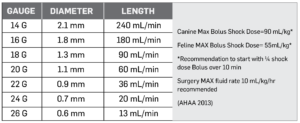IV Catheter Placement for Pets
Many of us have been taught to “go big or go home” when it comes to intravenous (IV) catheter placement, or IVC, in veterinary patients. This is especially true in Emergency and Critical Care medicine and surgery. For me personally, I was taught this mentality for more than 90% of my career. But after some digging and reflection, it might be time to try and reevaluate this mentality.
When We Use IVC Placement
We place intravenous catheters most commonly to administer medications, fluid therapy, and nutritional support to a pet. The catheter provides a pathway into the vascular system and also allows blood samples to be drawn (which is especially helpful for patients who need multiple samples or who have poor veins) with minimal patient discomfort.
“Go big or go home” refers to how big of a catheter you use. Many technicians reach for the 20 G or 22 G regardless of the patient’s size.
If It’s About Patient Comfort, Then Why Should We “go big or go home?”
Every time we place an IVC, we should try to consider patient care and what the patient needs. You can ask yourself: Do I need to “go big or go home”? Is it medically necessary for this patient’s treatment plan?
Let’s Do the Math

So this would mean that a 6 kg cat at ¼ shock dose that is receiving 83 mLs @500 mLs/hr and a 22 G IVC is capable of introducing ~2,160 mLs/hr of fluids @26 mLs/min. Should a 20 G IVC capable of introducing ~ 3,600 mLs/hr be necessary?
In a veterinary ER, we might not be thrilled about 24 G IVC’s in anything but neonates. I think it is worth trying to reconsider our “opinions” on these topics and have evidence to back-up our thoughts.
3 Common things caused by an IVC that is too large for the patient:
- Cause more inflammation and scarring of the vessel
- Decrease circulation to peripheral tissues commonly causing “fat paw”
- They are often very uncomfortable causing the patient to want to chew out the IVC
The next time you place an IVC, remember that there is a living being attached to that vessel!
Written by: Heather Scott RVT, LVT, VTS-ECC
Sources:
IVC gages and fluid rate capabilities: https://www.pedagogyeducation.com/Correctional-Healthcare-Campus/Resource-Library/Infusion/Peripheral-IV-Catheter-Chart.aspx
Fluid dose and rate recommendations: https://www.aaha.org/globalassets/02-guidelines/fluid-therapy/fluidtherapy_guidlines_toolkit.pdf, https://todaysveterinarypractice.com/resuscitative-fluid-therapy-for-circulatory-shock/ Deborah Silverstein